Parametric Analysis of the Combination of Rubber and Sliding Bearings for Seismic Isolation of Steel Structures
Naser Khorsand1 * , Seyyed Mehdi Dehghan Banaraki2 and Ali Ghodrat1
1
Department of Civil Engineering,
Islamic Azad University,
Shiraz,
Iran
2
Department of Civil Engineering,
Shiraz University of Technology,
Shiraz,
Iran
Corresponding author Email: naser.khorsand@gmail.com
DOI: http://dx.doi.org/10.12944/CWE.10.Special-Issue1.80
Human has always searched for solutions for mitigating the destructive effects of earthquakes on structures. One of the solutions to this problem that is currently under attention is the use of seismic isolation. In this method, a base isolation system is used to increase horizontal flexibility and the fundamental period of the structure so as to escape the range of earthquake destructions. The low damping rubber bearing used in this study demonstrated a linear behavior and adequate stiffness, but low energy dissipation. On the other hand, the sliding bearing demonstrated a high level of energy dissipation and a lack of ability to return to the initial state. The aforementioned isolators are both easy to build. Hence, a combination of these two bearings will yield an economic highly-efficient isolation system. This study was conducted on four- and eight-story structures with 3- and 5-span steel moment-resisting frames with an aim to find the optimum combination of the rubber and sliding bearings. SAP 2000 was used for the purpose of the nonlinear response history analysis. Two series of seven-piece accelerograms including near-source and far-source accelerograms were used. The combination of bearings was determined on the basis of far-source accelerograms while the performance of the combination was examined based on near-source accelerograms.
Copy the following to cite this article:
Khorsand N, Banaraki S. M. D, Ghodrat A. Parametric Analysis of the Combination of Rubber and Sliding Bearings for Seismic Isolation of Steel Structures. Special Issue of Curr World Environ 2015;10(Special Issue May 2015). DOI:http://dx.doi.org/10.12944/CWE.10.Special-Issue1.80
Copy the following to cite this URL:
Khorsand N, Banaraki S. M. D, Ghodrat A. Parametric Analysis of the Combination of Rubber and Sliding Bearings for Seismic Isolation of Steel Structures. Special Issue of Curr World Environ 2015;10(Special Issue May 2015). Available from: http://cwejournal.org?p=744/
Download article (pdf) Citation Manager Publish History
Select type of program for download
| Endnote EndNote format (Mac & Win) | |
| Reference Manager Ris format (Win only) | |
| Procite Ris format (Win only) | |
| Medlars Format | |
| RefWorks Format RefWorks format (Mac & Win) | |
| BibTex Format BibTex format (Mac & Win) |
Article Publishing History
| Received: | 2014-11-20 |
|---|---|
| Accepted: | 2014-03-15 |
Introduction
Seismic isolation systems are a proper solution for reducing the adverse effects of earthquake on structures. When the objective is to protect structural members or important equipment in a building, it is possible to use seismic isolators to limit the transfer of the energy produced by ground vibratory motions to the building. In this method, as an earthquake occurs, structural deformations are concentrated on highly flexible bearings and the structure experiences vibrations as a rigid object with small deformations. The isolation system is effective for low-rise and relatively rigid structures and is less effective for high-rise and soft buildings. Installation of seismic isolation systems in buildings leads to a substantial increase in the fundamental period of structures. Hence, using isolation systems somehow all the demand for structural seismic deformations is concentrated on these systems. As a result, a drastic decrease is observed in the earthquake force acting on the main structure. In the studies of sliding bearings, a suitable friction coefficient will control the force transferred to the superstructure and lateral displacements of the structure. In order to generate a restoring force in systems with sliding bearings it is recommended to simultaneously use rubber and sliding bearings. This way the restoring force in the system is supplied by the rubber bearing while the energy dissipation process is run by the sliding bearing. In developing numerical models of the behavior of the system of interest it is necessary to consider the combination of the behaviors. However, research results along with relevant codes and regulations clearly reflect the effect of using isolators on the seismic behavior of structures. The system using a combination of rubber and sliding bearings demonstrates the following behavior:
- Use of rubber bearings to increase the natural period of the structure;
- Use of sliding bearings to control the maximum force transferred to the superstructure, to dissipate the energy at the bearing, and to limit displacements of the bearing
The results of the present study are expected to provide a suitable framework for assessing the effect of simultaneous use of rubber and sliding seismic isolators on the seismic behavior of steel structure. The combination of the two isolators is expected to have the capacity to absorb energy and return to the initial state (restore).
Methods
Structural Modeling and Specifications of Accelerograms
For the purpose of this study, the two-dimensional analytical model of 4- and 8-story three-span steel moment-resisting frames was used. The performance of these frames was examined using rubber and sliding bearings with friction coefficients of 1, 2 and 4. The length of the frame spans was 6 meters and the height of main stories was 4 meters. The frames were modeled, analyzed and designed in SAP 2000 V16. Steel frames with average plasticity were used for type 2 soils and were loaded according to the 2800-84 Standard in a location relatively prone to earthquake1 The frames were designed using the limit method introduced in section ten of the national building regulations. Figure (1) shows the sections of columns and beams used in this study.
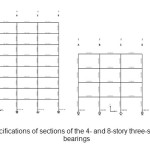 |
Figure 1: Specifications of sections of the 4- and 8-story three-span frames with bearings |
Dynamic analysis was carried out using the nonlinear response history analysis method and 14 accelerograms obtained from the California Department of Mines and Geology (CDMG). Earthquakes suitable for modeling buildings with seismic isolation systems were selected considering their near-source and far-source effects. The specifications of these accelerograms are presented in tables (1) and (2) along with their intensity and location information4
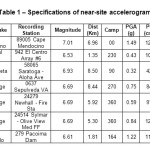 |
Table 1: Specifications of near-site accelerograms Click here to View table |
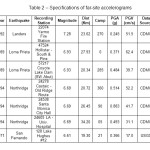 |
Table 2: Specifications of far-site accelerograms Click here to View table |
Analytical Model
Flat sliding isolation systems are analyzed with a simple procedure compared to other isolation systems as their performance is not a function of their size. Two parameters are used to define the characteristics of these isolation systems:
- Characteristic strength which is shown by Wμ where μ is coefficient of friction for the sliding surface and W is the total seismic weight.
- Post-yielding stiffness is assumed to be zero for a flat sliding bearing.
In sliding bearings a fully elastic plastic element with a high initial stiffness is used. The yield point of this element is a function of velocity and vertical pressure. Any possible uplift will be accompanied by a gap element and the shear strength during the uplift will be zero. In this study, invariant friction coefficients of 1, 2 and 4 were used.
Plastic systems are modeled as linear elastic springs with a very large yield point. Both isolation systems were calculated based on the effective weight of the structure during earthquake and results for the internal and external isolation systems are different.5
Results and Discussions
In this section, the parameters influencing the uplift of isolated structures such as the effect of far-site and near-site earthquakes, the number of stories, number of structural spans, and the effect of isolator period. A comparison was also made between systems with and without isolation systems with regard to the aforementioned parameters.
Dynamic Characteristics of Frames
Table (3) presents dynamic characteristics of four- and eight-story frames (with 3 and 5 spans) in the absence or presence of isolators with friction coefficients of 1, 2 and 4. The dynamic characteristics presented in this table include the structural period and modal participating mass ratios in the main three modes. The presence of the isolator led to an increase in the modal participating mass ratio in the first mode.
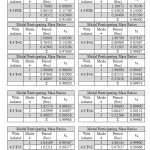 |
Table 3: Dynamic characteristics of frames: A) The eight-story three-span frame (on the left) B) The four-story three-span frame (on the right); Click here to View table |
Restoring Force Control
According to UBC, with a displacement three times the design displacement it is necessary to design systems without restoring forces. This significantly influences P-Δ forces, separation distance, isolation costs and other components. Systems should be designed to generate restoring forces if possible.
The restoring force is defined as the design displacement force that is at least 0.025W times the force generated half way through the displacement. The restoring force condition is a complete condition and does not solely apply to earthquakes. Hence, when the overall force is small as part of the seismic weight, problems may be caused in zones with low seismicity. In such zones, it is sometimes impossible to incorporate sliding bearings into the isolation systems and follow the UBC requirements for restoring forces. However, in zones with low seismicity, it is possible to carry out designing and detailing procedures for a displacement three times the calculated seismic displacement.6
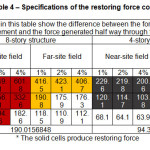 |
Table 4: Specifications of the restoring force control Click here to View table |
The Effect of Isolator Period
The Effect of Isolator Period on the Building Base Shear
Figure (2) shows the results of dynamic analyses of an 8-story three-span frame, an 8-story five-span frame, a 4-story three span frame and a 4-story five span frame in near-site and far-site experiments.
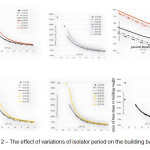 |
Figure 2: The effect of variations of isolator period on the building base shear Click here to View figure |
According to the results it can be concluded that variations of the isolation system period leaves a considerable effect on the building base shear. However, an increase in the number of spans does not have a significant effect on the performance of the isolated structure.
The Effect of Isolator Period on Base Level Displacements
Figure (3) shows the results of dynamic analyses of an 8-story three span frame, an 8-story five span frame, a 4-story three span frame and a 4-story five span frame in near-site and far-site experiments.
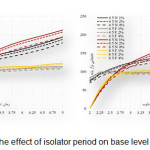 |
Figure 3: The effect of isolator period on base level displacements Click here to View figure |
The Effect of Isolator Period on Roof Level Displacements
Figure (4) shows the results of dynamic analyses of an 8-story three span frame, an 8-story five span frame, a 4-story three span frame and a 4-story five span frame in near-site and far-site experiments.
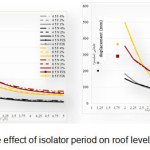 |
Figure 4: The effect of isolator period on roof level displacements |
As seen in the above figures, the maximum roof displacement in the 4-story isolated building is very close to the base level in near-field earthquake and is below the base level in far-field earthquakes. The maximum roof displacement in the 8-story isolated building is also very close to the base level in near-field earthquakes and is much below the base level in far-field earthquakes. Hence, it is conclude that in mid-rise buildings an increase in the duration of employment of the combined isolator can lead to a decrease in the maximum roof displacement. Evidently, with an increase in the number of stories, the combined isolation system will reduce maximum roof displacements in relation to the base level.
Excessive displacements shall be prevented to be able to obtain a proper structural design. In addition, one of the factors leading to the destruction of structures is the P-Δ effect. Hence, an increase in the displacements of the level above the isolator will increase the P-Δ effect on the isolator and lead to destruction of the isolator. Therefore, in order to obtain the ideal design the designer shall find a logical relationship for the increased design structural period which will reduce the base shear and will increase displacements.
The Effect of Isolator Period on Inter-Story Drift
Figure (5) shows the results of dynamic analysis of an 8-story five span frame and a 4-story five span frame in near-site and far-site experiments.
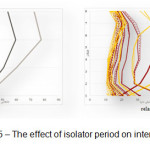 |
Figure 5: The effect of isolator period on inter-story drift |
As seen in Figure (5), the inter-story drift in rigid structures (the 4 story building) declined about 60%. This result can be very helpful in the design of such structures because the isolator can distribute the drift among all stories and therefore reduce the overturning moment of the structure. It is worth mentioning that according to the above figures, isolators have a smaller effect on inter-story drift in less rigid structures.
According to the above figures, the reduction in the inter-story drift (in relation to the base level) in isolated structures in far-site earthquakes is significantly higher than the inter-story-drift in near-site earthquakes. However, the difference observed in the performance of structures with different isolator periods is negligible for both the far- and near-site earthquakes.
Examination of an Ideal Design
As mentioned, a period ranging between 3 and 4 seconds along with a combination of the bearings under study give an ideal design for the structure. An increase in the design period will lead to a near-site reduction in the base shear, a reduction the inter-story drift, an increase in the base level displacements, a decrease in the roof level displacements, a decline in the inter-story acceleration, and generation of restoring forces.
Conclusions
Findings of this study can be summarized as follows:
- In the 4- and 8-story structures, the shear force transferred to the base declined and the reduction in the shear force observed in the more rigid structure (4-story structure) was drastic. That is to say, the transferred base shear force in the structure with an isolation system declined from about 50% to 80% as compared to a typical frame. This trend was seen in all of the accelerograms. Although the reduction was not this drastic in the 9-story frame, the reduction in the base shear force was negligible.
- An increase in the isolator period in far-site earthquakes leads to a larger increase in the shear force transferred to the base as compared to near-site earthquakes.
- An increase in the coefficient of friction of the sliding bearing leads to the growth of the shear force transferred to the base.
- Based on the results obtained by using isolators in the structures, it can be said that the increase in the period leads to an increase in structural drift. Moreover, the less the increase in the period is, the smaller the displacements from the restrained state will be.
- The increase in the isolator period in far-site earthquakes is almost invariant for the base level drifts. However, base level drifts in near-site earthquakes grow significantly as the period escalates.
- An increase in the coefficient of friction of the sliding bearing leads to a decrease in the base level drifts.
- Seismic isolation led to an increase in lateral displacements as compared to the restrained state.
- With an increase in the isolator period the near-site increase in lateral displacements will be more than far-site lateral displacement. Use of seismic isolators in far-site earthquakes is more effective than its use in near-site earthquakes.
- An increase in the coefficient of friction of the sliding bearing will lead to the rise of lateral displacements in buildings.
- The maximum roof displacement in the 4-story isolated building in the near-field earthquake was very close to the base level but was below the base level in the far-field earthquake. Similarly, the maximum roof displacement in the 8-story isolated building in the near-field earthquake was very close to the base level but was below the base level in the far-field earthquake.
- In the mid-rise buildings, with an increase in the period it is possible to use this isolation combination to reduce maximum roof displacements. Evidently, with an increase in the number of stories, the use of this combined isolation system will reduce maximum roof displacements in relation to the base level.
- An increase in the coefficient of friction of the sliding bearing leads to the growth of maximum roof displacements.
- Inter-story drifts in rigid structures (4-story building) declined about 60%. This finding can be very useful for the design because the isolator distributes the drift among all the stories and therefore reduces the structure’s overturning moment. In softer structures the isolator leaves smaller effects on inter-story drifts.
- An increase in the isolator period in far-site earthquakes leads to a considerable reduction in the inter-story drifts as compared to near-site earthquakes.
- An increase in the coefficient of friction of the sliding bearing will lead to the growth of inter-story drifts.
- In this study, the structural behavior somewhat differed from the behavior of the isolated structures with an increase in the number stories, especially in high-rise buildings with over 8 stories. As a result, the characteristics of these buildings became similar to those of restrained buildings.
- As mentioned, a period ranging between 3 and 4 seconds along with a combination of the bearings under study give an ideal design for the structure. An increase in the design period will lead to a reduction in the base shear, a reduction the inter-story drift, an increase in the base level displacements, a decrease in the roof level displacements, and a decline in the inter-story acceleration. A friction coefficient of 4% results in a more idealistic behavior for the combined system.
- Isolated steel structures with maximum number of 4 stories demonstrated relatively rigid behaviors regardless of their superstructure systems. Therefore, the performance level of these structures is very high and they are considered ideal for the use of isolation systems. As a result of an increase in the number of the superstructure stories the effects of higher modes become more evident. In general, an increase in the number of superstructure stories of isolated buildings leads to the growth of inter-story drifts and a consequent reduction in the seismic performance of such buildings in similar conditions.
- With an increase in the structure’s period the potential for generation of restoring forces declines. Therefore, the potential for generation of restoring forces in far-site earthquakes is much higher than near-site earthquakes. Moreover, an increase in the friction coefficient will also contribute to the reduction in the potential.
- Changes in the period of the isolation system considerably influence the seismic performance of structures at different seismic risk levels. That is to say, the seismic performance of isolated steel structures is significantly influenced by this parameter. An increase in the number of stories also will intensify this impact.
- An increase in the natural period of the structure leads to a decrease in its seismic responses and a decline in the structural acceleration. As a result, the amount of forces in the structural members declines and the degree of damages caused to the structure also drops. Although the reduction in acceleration in high-rise softer buildings is lower than rigid structures, it cannot be neglected. The reduction observed in far-site earthquakes is considerably larger than near-site earthquakes.
References
- Permanent committee on supervision of the seismic design of buildings, Seismic Design of Buildings Regulations 2800-84 Standard, (Tehran Building and Housing Research Center, 2009).
- National Building Codes Development and Promotion Office, Design and implementation of steel structures topic 10, (Tehran, Tosse Iran Publications, 2009).
- PEER (Pacific Earthquake Engineering Research Center) Strong Motion Database, University of California, Berkeley, http://peer.berkeley.edu/.
- Naeim, F. and Kelly, J.M., Design of Seismic Isolated Structures: From Theory to Practice, (John Wiley and Sons, Inc, 1992).
- Salehin, A and Muhammadi, H, Design and implementation of seismic isolators, (First edition, Tehran, Farahmand Adena University Press, 2014).
- Specialized Committee of Housing and Urban Development Department ,Design code for buildings with seismic isolators, (Center for Building and Housing Research Publications, 2010).
- National Management and Planning Organization, Codes for rehabilitation of existing buildings, Journal no. 360, Technical Deputy, Technical Deputy Office, (Department for Criteria Development and Reducing Earthquake Risks, 2006).
- National Building Codes Development and Promotion Office, Loads exerted on buildings (topic 6), (2nd edition, Tehran, Tosse Iran Publications, 2006).
- Strategic Supervision Deputy of the Technical System Administration, A guide to the design and implementation of seismic isolation systems in buildings Journal no. 523 (2010).







